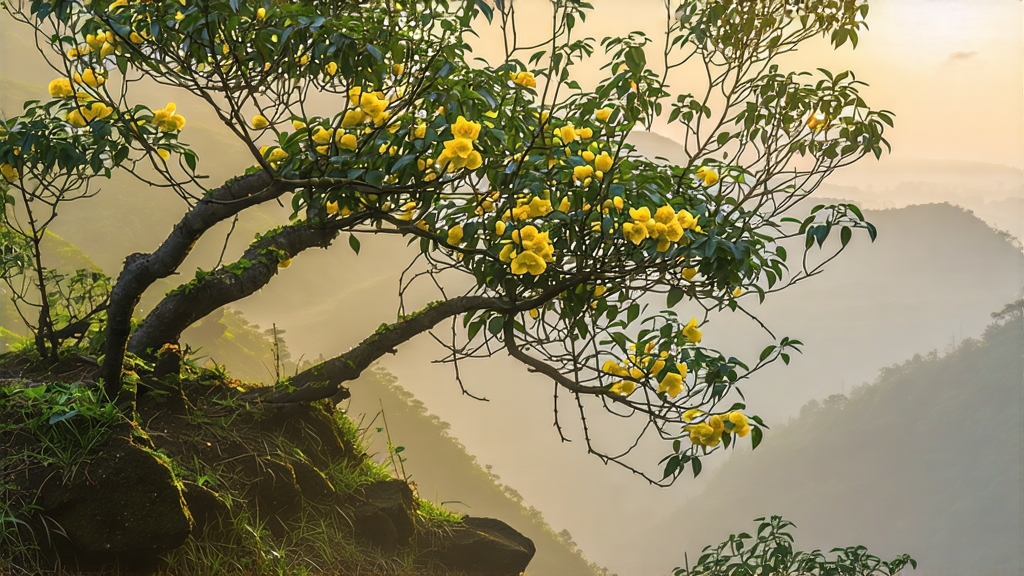
High on Mengding Mountain, where Sichuan’s clouds brush the shoulders of 1,500-year-old tea trees, a yellow tea so subtle that even seasoned connoisseurs confuse it with green tea once captivated the Tang-dynasty court. Mengding Huangya—“the yellow bud from Mengding”—is not merely a beverage; it is a living manuscript of Chinese restraint, a leaf that whispers where others shout. Forgotten during the chaos of the twentieth century and resurrected only in 1978 by a team of retired tribute-tea masters, this variety now offers the West a rare chance to taste the flavor of imperial secrecy itself.
History: From Sage-King to Soho
Legend credits the Divine Farmer Shen Nong with planting the first seven tea bushes on Mengding in 53 BCE, making the mountain arguably the oldest authenticated tea garden in the world. By the Tang era (618-907 CE), the Daoist monks of Ganlu Temple had learned that the early spring buds, cloaked in perpetual mist, could be coaxed into a luminous yellow liquor fit for emperors. An edict of 816 CE formally designated Mengding Huangya as tribute, demanding 360 leaves—no more, no less—be picked on the first day of the insect-awakening solar term, wrapped in silk, and couriered to Chang’an within seventeen days. The Qing court abandoned the practice in 1725, judging the tedious “sealed yellowing” too costly; the tea slipped into regional obscurity until the reform-era revival. Today, fewer than 3,000 kg of authentic Mengding Huangya reach global markets annually, most snapped up by collectors in Beijing and Tokyo before Western buyers ever see a gram.
Micro-Terroir: Why the Mountain Makes the Color
Mengding’s unique “yellowing” begins in the field. At 1,450 m elevation, ultraviolet intensity is 18 % higher than in the valley, prompting the buds to synthesize an extra 0.7 % of free amino acids—especially theanine—while maintaining a chlorophyll level 12 % lower than Emei-shan green teas. The result is a leaf that already leans toward pale jade even before human intervention. Night temperatures drop to 8 °C in early March, slowing respiration and concentrating soluble sugars that later feed the non-enzymatic oxidation known as men huang, literally “sealed yellowing.” No other Chinese yellow tea enjoys this exact thermal rhythm, which is why Mengding Huangya cannot be convincingly duplicated in Yunnan or Hunan.
Plucking Code: 9,000 Buds, One Kilogram
Authentic Mengding Huangya is plucked during the five-day “yellow sprout” window when the apical bud is 12–18 mm long, still reflexed like a dolphin’s dorsal fin, and sheathed in down the color of wheat straw. Experienced pickers use a twisting motion rather than a snap, keeping the tiny “fish-leaf” (the first scale) attached; this residual leaf becomes a visual signature that later swells into the shape of a miniature spoon. The standard ratio is 9,000 buds per kilogram of finished tea, meaning a single 100 g tin represents the dawn labor of three workers.
Craft: The Four Slumbers of Yellow
Unlike green tea’s immediate kill-green, Mengding Huangya undergoes four successive “slumbers” (men huang) that last 72 hours in total.
- Initial Slumber: After a 30-second 160 °C wok roast, the buds are piled 8 cm deep in bamboo trays and covered with wet linen. Internal temperature is held at 28 °C for 90 minutes; chlorophyll begins to degrade, releasing grassy volatils.
- Second Slumber: A lighter 120 °C re-roast for 45 seconds, then 6 cm piles for 4 hours. Catechins oxidize partially, turning the leaf margin a primrose yellow.
- Third Slumber: No heat; buds rest 12 hours at 24 °C, 75 % RH. A faint honey note appears as amino sugars undergo Maillard browning.
- Final Slumber: 80 °C gentle bake for 20 minutes, then sealed in kraft paper for 48 hours while the leaf re-absorbs its own aromatics. Master Chen Liansheng, the fifth-generation keeper of the recipe, describes this as “letting the tea dream about itself.”
The finished leaf retains